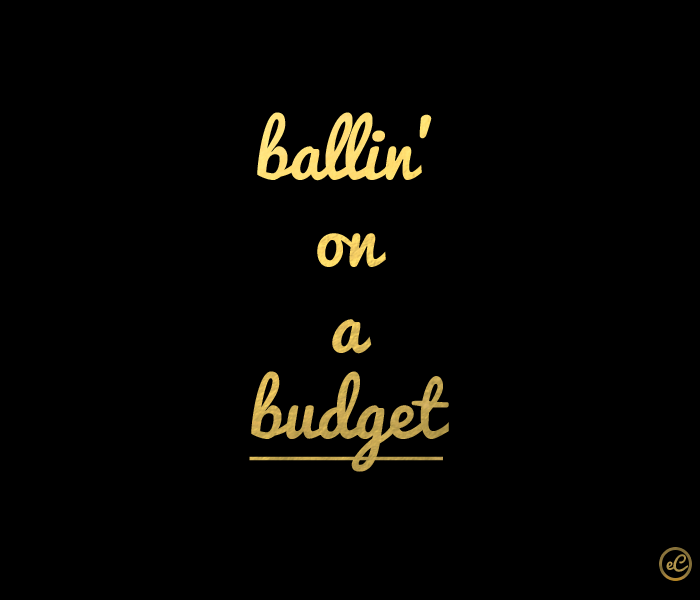I wrote a previous blog on money management where I shared some tips on how to identify where you are wasting money and then gave my own personal formula (via an downloadable excel spreadsheet found here) the gauge all of your spending. If you are coming from that blog, then you are in the right place. If you are just looking at this blog for the first time, it may be prudent to go back and check out the previous one I wrote or at least download the excel spreadsheet because you will need it for the next step.
Step 2 – Formulating a simple budget that you will actually follow.
It was told to me early on in life by a very wealthy mentor of mine who I respect dearly that if I couldn’t manage $1, then I couldn’t manage $1 Million dollars. This is so true, I meet people all the time who’s personal finances are garbage even when they are making great money in their career.
It all comes down to money management and budgeting. Again, this is another common thread among all wealthy people I have ever met; they all have a budget based on a formula that uses money as a tool never spending it emotionally. Here is what to do.
Take that excel spreadsheet you just downloaded. (or get it here)
The idea here is very simple. Manage any and all money that you get. EVERY SINGLE CENT! If you know what your monthly income is, it becomes very easy to budget, if you are like me and get paid in lump sums sporadically then disciplining yourself to a system like this is crucial!
Ok so here is how it works: For every dollar I take in, it gets split up and put in to different bank accounts. Each bank account represents a different aspect that I am saving for. In my case I have 8 Bank accounts. I explain what I use them for and the benefits.
- Wells Fargo Checking / Savings account – This account is used for daily spending, and paying bills. Think of it as your most active account, all money is deposited here before it goes to other accounts.
For daily spending and bill payment, I like Wells Fargo. The important thing to remember here is to bank with a bank that is convenient to for you with lots of locations and low fees across the board. As of right now, I pay NO FEES with Wells. I think B of A is the worst, and Chase Bank is in the middle when it comes to big banks.
- Discover Bank # 1 – Taxes (This is where I said aside money for taxes every year)
- Discover Bank # 2 – Emergency Fund account (Save for a rainy day)
- Discover Bank # 3 – Long Term Savings (Use for large purchases like a house or car etc.)
I use Discover bank because they give you the highest rate of return for a savings account. 0.95% to be exact and…
- No minimum deposits
- No Account Fees
- Open as many accounts as you want
- Capital One 360 # 1 – Annual Expenses account (Money set aside for annual expenses like car insurance, property tax etc.)
- Capital One 360 # 2 – Vacation Fund (Saved money for Vacations)
I use Capital One 360 because they pay a pretty good rate of return on money in savings and my account doubles over as my top pick for a travel debit card that has
- No minimum deposits
- No Account Fees
- Open as many accounts as you want
- NO foreign transaction fees
- No ATM banking fees.
- Wealthfront Account – Managed Portfolio Long term investing account
- FXCM Account – This is my active foreign currency trading account as I trade currencies daily. If your are interested in learning how to trade I wrote a blog about it here, otherwise, dedicate the 5% I am setting aside in this account to some other find or investment.
Now take some time to look it over the excel spreadsheet. If you need to open a couple accounts, don’t worry, this can literally be accomplished in an hour, follow the links above to use my recommendations, or feel free to open up accounts where your want to.
Keep in mind that I am a 1099 independent contractor that means I pay my own income taxes each year. If you are a W-2 employee, then you can zero out the taxes line because your taxes are collected before you get paid. Personally I set aside 18%-20% a year for myself, you may pay less or more depending on how much you make and what your tax liabilities look like.
- Enter all of your monthly and annual expenses. (You will see some numbers starting to populate)
- Replace my bank accounts with your banks and match them closely as possible, meaning if you have a normal B of A or Chase Checking and savings account, that should be your main account at the top. If you have an E*TRADE, Schwab or IRA, replace my Wealthfront account with yours etc.
- If there are some areas where you will need to set up new bank account, leave them blank for now
- Now enter in your monthly income at the top in the yellow (total monthly Colum)
- By now you should see some of the boxes populating. I will explain what’s happening here
The Breakdown.
Ok by now you probably have a good idea of what I am driving at here, but I will explain anyway. This formula is partitioning all of your income into different savings columns to give you a well rounded and financially savvy money management system.
The breakdown as seen in my excel sheet looks like this.
- I earn $100
- $20 (20%) is saved for taxes and taken right off the top (Skip step if you are a W-2 employee)
- Now I have $80 Left
- $40 (50%) Goes to my living expenses, i.e. rent, mortgage, car payment, food, gas etc.
- $10 (10%) – To the emergency fund, after all shit happens.
- $10 (10%) – Long-term savings fund. This could be for a future large purchase like a car or house down payment.
- $8 (8%) – Annual Expenses Account – Like car registration or medical/life insurance. Things that get paid once per year
- $7 (7%) – Vacation Fund – To broke to take a vacation, do this for a year, and I promise you that you will have enough to take a vacay!
- $10 (10%) – Long-term investment account – YOU NEVER TOUCH THIS MONEY! This is for your retirement. You may be thinking I’m way to young to start saving for retirement, but the difference between starting this habit at 20 years old compared to 30 years old will mean a difference of hundreds, yes I said hundreds of thousands by the time your retire. So don’t fuck around with this one, set the 10% aside and forget about it.
- $5 (5%) – For me it goes to an active trading account that I personally trade. If you have no desire to learn how to actively trade, you can simply put this money towards some other kind of investment short term to medium term, but this money is not for bullshit, it’s money set aside for short-Medium term investments with a bigger return on the short side.
Conclusion
This whole idea was adopted after first reading the age old book The Richest Man in Babylon. When done correctly you will learn to pay yourself first and then save and invest the rest of it leaving a little hear and there for having a good quality of life.
My parents generation saved about 20%-30% of there income on average. My generation saves a measly 5%-10% and knowing that we are going to need a least a cool million to retire on (4 times as much as my parents will need) we need to get on this today. There is literally no time to waste.
Again, if you are in debt, or not making a lot of money, apply this formula anyway. Rework the numbers to make them fit your situation. If you are in some serious debt, check out my blog on &^%&^%&*^%&* if you are just not making that much or spend money stupidly, then I challenge you to try this for 90 days. If after 90 days you don’t feel like you have a better handle on your finances and that you are heading in the right direction, comment here and I will jump out of an airplane to promote what ever you want me to.
Money is a tool. It is only emotional when you don’t have enough of it. It controls you, or you control it, simple as that.
****And as a bonus, if you are still not convinced, Acorns is a nifty little app that allows you to invest pocket change from rounded up expenditure in to the market as a long term investment. Follow this link to check it out and get $5 for opening an account.
Did you mis part 1 of this blog? Read it here!

